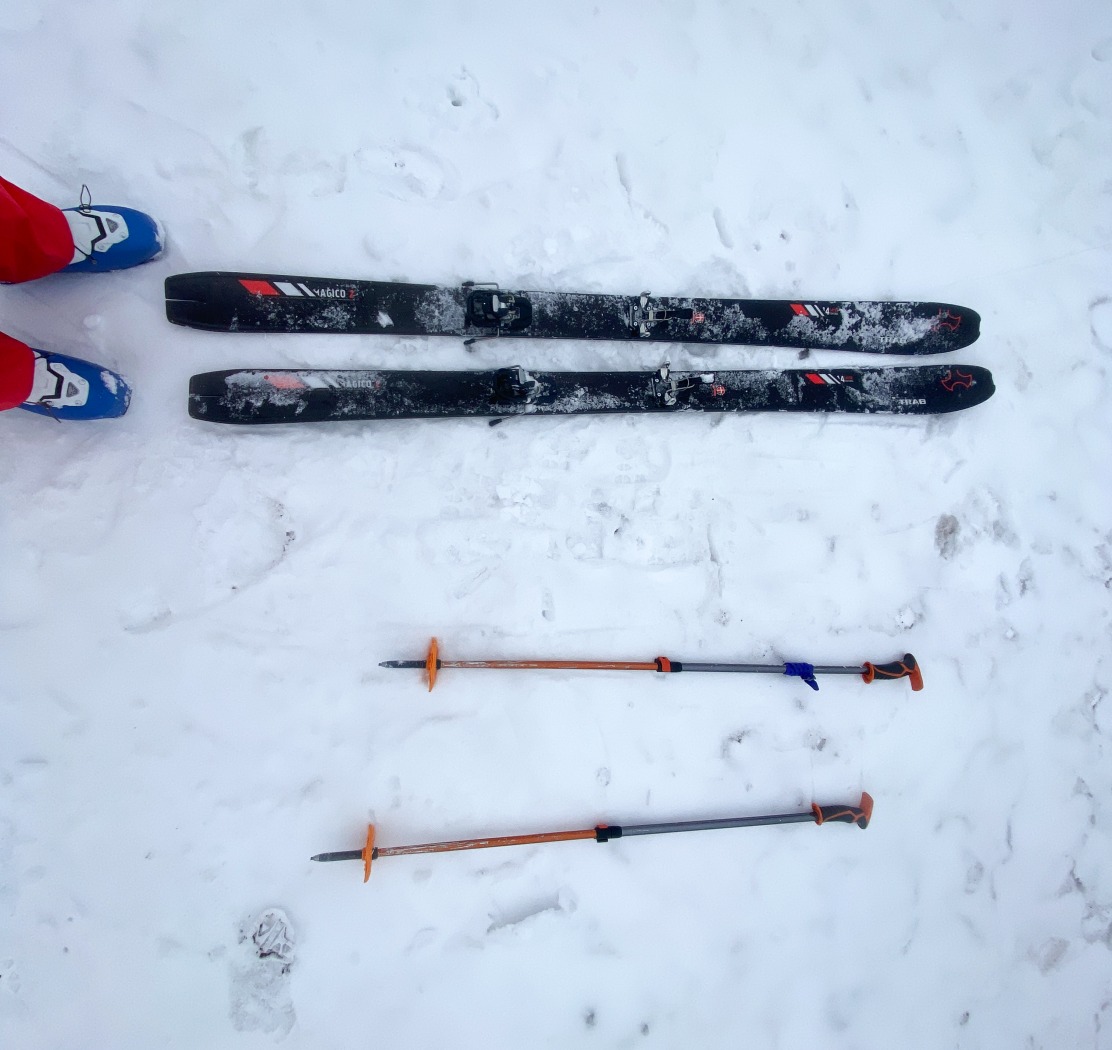
The Ski Trab goods: Magico.2 ski, Titan Vario.2 binding, and branded 100% skins.
Although winter has persisted through April, and now May, in the Pacific Northwest—and we have yet to enter the heart of volcano season—I’ve gotten to know the Magico.2 skis quite well. I’ve continued to be impressed with the control they maintain through choppy and variable conditions. On firm snow, I have yet to get them to chatter at speed (and I’ve tried!). As I peruse back through Ski Trab’s manual and website, I now understand why.

Click here for the Ski Trab Magico.2 skis, Titan Vario.2 binding and branded mohair skins first look.
The Skis
The Magico.2 skis are part of Ski Trab’s “Emotion and Control” line, which also includes the Maestro.2, Ortles, Bernina, Gavia, and Stelvio (which are all within 76-88 mm underfoot). According to Ski Trab, the goal of this ski style is to balance the thrill of a hard-charging descent with the control required to make precise turns. To achieve this, Ski Trab cites its 14-Layer Control Technology, which I dug into a bit more as I got to know the skis; 14 layers, that’s a lot.
Key among these layers are the wood and aramid core. Aramid is a lightweight and flexible synthetic fiber used in aerospace and military applications due to its exceptional strength-to-weight ratio. Ski Trab combined this honeycomb-like composite with (what the company calls) light wood (which is very lightweight) and ash (which is a more dense but highly flexible hardwood) to create a ski core that’s strong and durable, yet extraordinarily light. Ski Trab calls this combination of materials the “Liwood Air Core”—to put it simply, the ski’s core contains a lot of lightweight materials and air, with enough hardwood to provide structure, durability, and torsional rigidity.
Other techy-yet-noteworthy features include Ski Trab’s “Hibox torsion control”—a micro-mesh carbon cage that’s wrapped around the ski as part of its 14-layer construction. The purpose of this layer is to increase the ski’s torsional stiffness (and thus stability at speed) without compromising its flexibility (and ease of turning). In addition, Ski Trab utilizes structural polymer components as well as elastamer along the length of the ski to absorb shock and vibrations. What’s all this tech talk mean? The ski doesn’t chatter and it remains stable at speed. It’s one thing for a company to wow with lighter, more rigid, and many layers. It’s another to deliver on the claim of solid skiability in the world of space-age materials. .
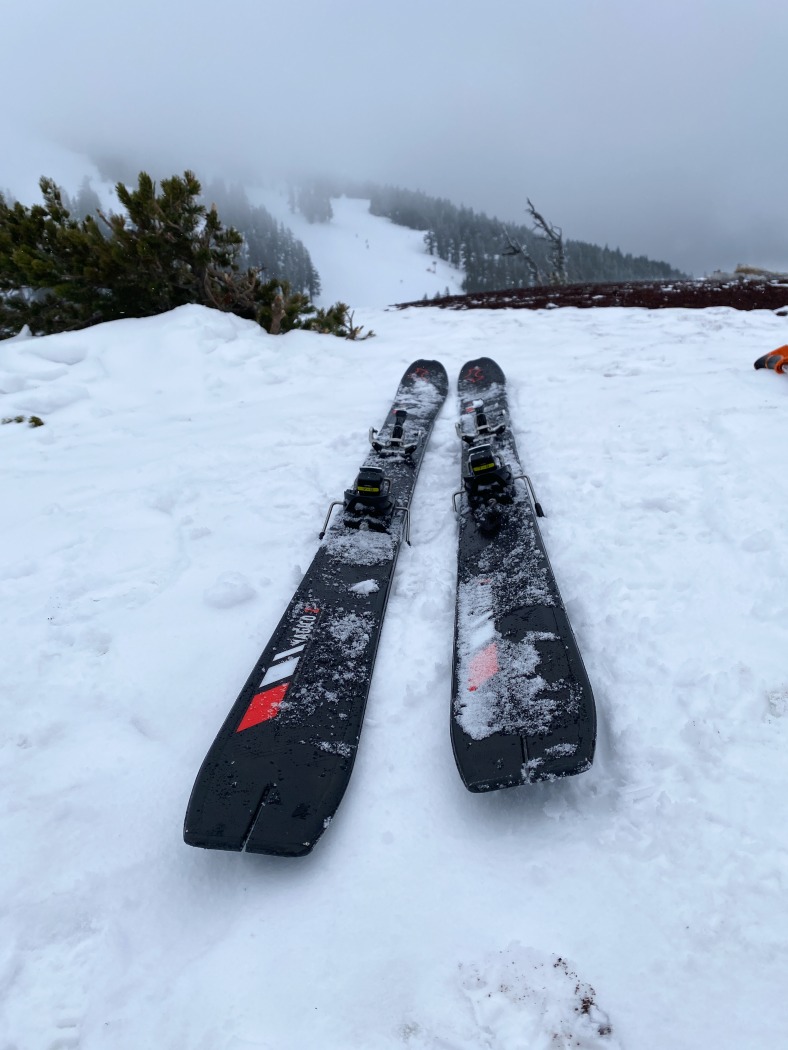
The Magico.2s are a solid ski mountaineering choice as the tail, with minimal rise, can be inserted into compact snow with reality ease in the event you set up an anchor.
Finally, less techy but equally as important: Ski Trab updated the Magico.2 skis with more flex and a higher turn radius to help drive the skier through the turn. According to its manual, Ski Trab lengthened and reshaped the ski’s tip and tail, moving the widest part of both the tip and the tail forward—this has the benefit of increasing the ski’s effective length. The longer tip and tail are intended to provide more float in powder, while the new shape is designed to improve steering. Ski Trab also increased the flex in the tip in the tail, which combines with the higher turn radius to help facilitate and improve control through each turn.
Most of my days on the Magicos have been in variable conditions. I’ve found that overall, these skis feel effortless on the ascent and they consistently perform better than expected on the descent. They hold their own through the chop and hardpack and they are fun and playful in shallow powder. While Ski Trab describes the Magicos as skis for “all snow conditions”, I would not recommend them as a one-ski quiver, nor would I reach for them on the deepest powder days.
I also think it’s worth noting that Ski Trab’s video for the Magico.2 and Maestro.2 skis describes these skis as “for expert skiers.” Indeed, I would not recommend the Magico.2 for beginner skiers, because I think there are more forgiving options on the market and the Magico.2 demands precision and good ski form. Instead, I would recommend the Magico.2 as a great super-light spring ski and ski mountaineering option that will reliably perform wherever your ski objectives take you.
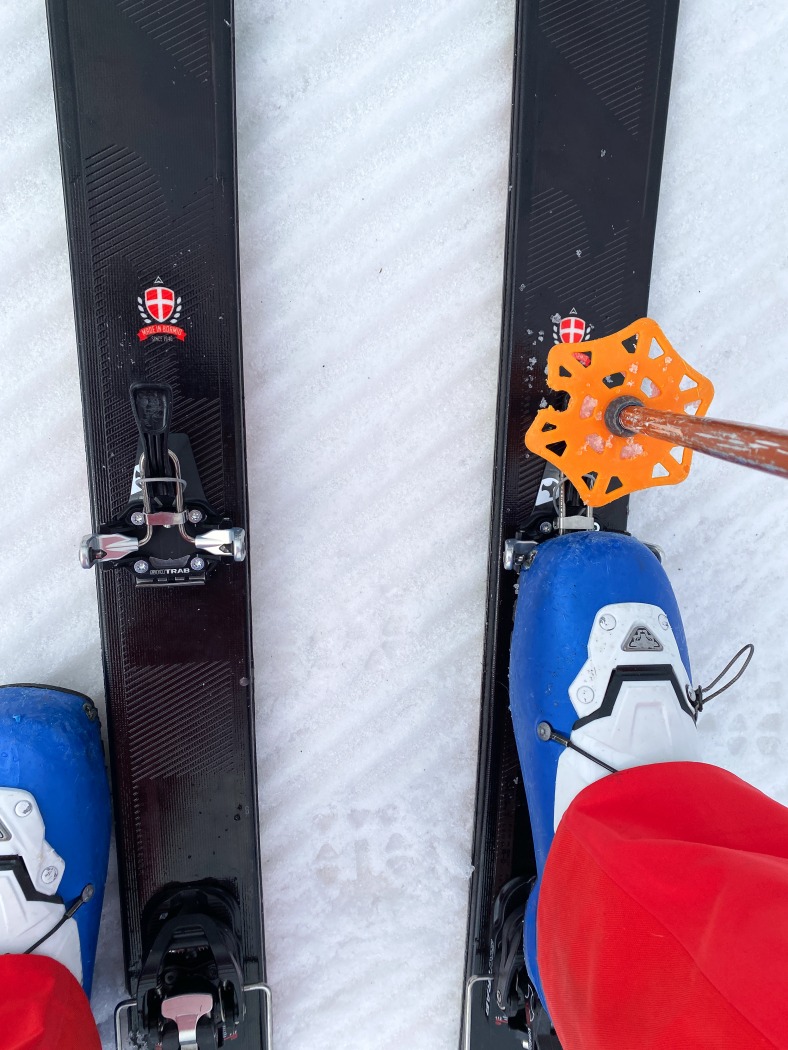
Looking down on the Ski Trab Titan Vario.2 binding. Unlike most tech bindings in which the skier steps to engage the toe lever, the Titan Vario.2 requires the skier to press down on the toe lever, then release, once the pins are aligned.
The Bindings
The Titan Vario.2 is an impressive binding, and a few key design elements are worth a callout. The toe piece is a simple design made with a U-shaped titanium that’s strong, flexible, and lightweight. The titanium piece integrates with a titanium elastic spring and independent jaws to create a simple and secure toe attachment that flexes and moves symmetrically, making an accidental pre-release unlikely. While crossing avalanche terrain during an ascent, simply unlock the toe piece—the design will keep the jaws in place while making release easier in case of an avalanche. I find this design particularly unique because I have known Dynafit bindings to consistently let go of my boot if the toe piece is not locked (on the ascent). Ski Trab’s spring mechanism allows me to tour with the toe piece unlocked without fear of losing the ski (if I’m in avalanche terrain) while reducing the chance of pre-releasing on the descent (which I think about in particularly steep and icy or variable conditions).
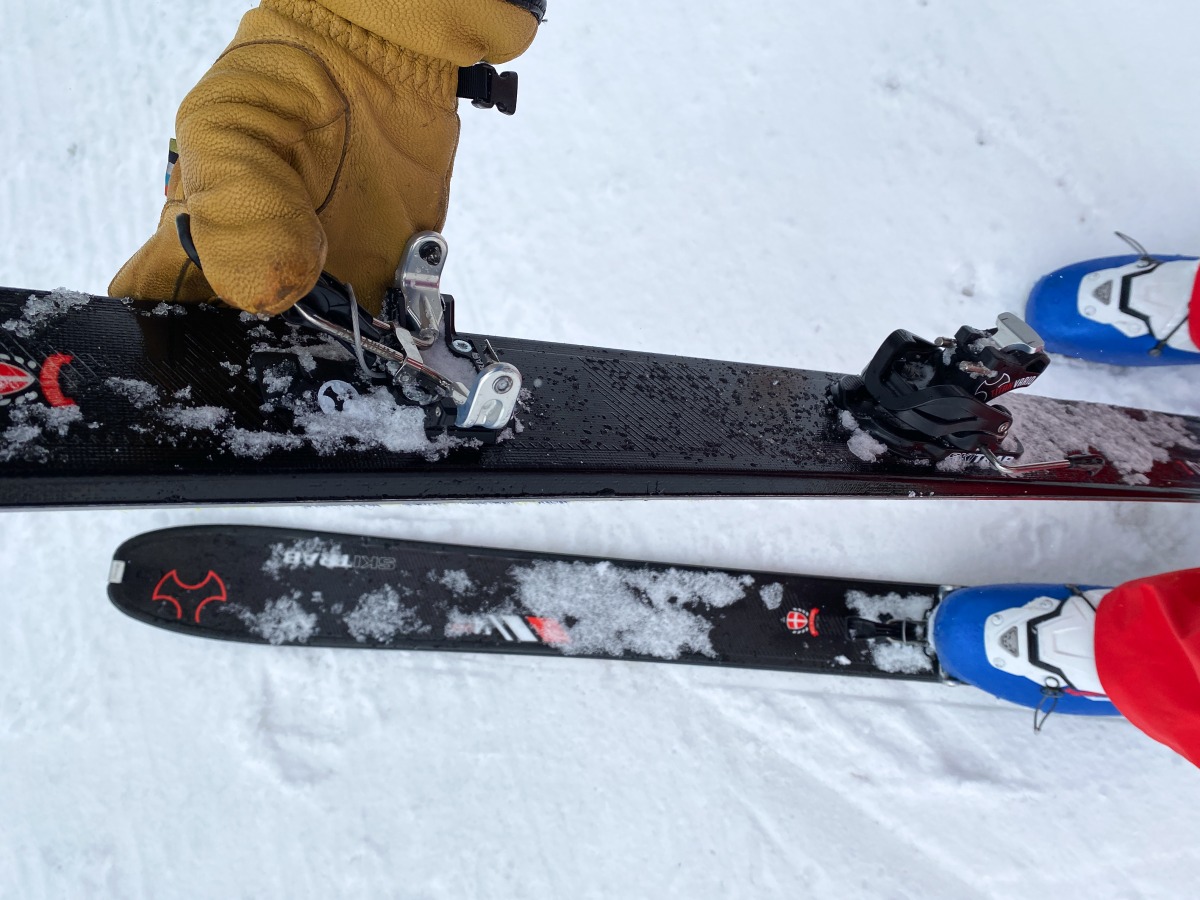
Although for the more flexible among us, the skier can press down on the toe lever as shown to begin the step-in process.
Ski Trab’s video about the Vario.2 shows two ways to step into the binding. One is intuitive: use a ski pole to push down on the toe piece, line up the toe of your ski boot with the pins, and then release the spring and watch the jaws clamp into place. The other method, “for the more experienced” user, is to hold the ski up with one hand, using that same hand to hold the toe piece down, and then lift your leg and step into the ski while holding it in the air. This method is intended for difficult terrain, likely steep and icy conditions where you may not want to put the ski down in order to step into it (especially if you don’t have brakes or leashes). While I appreciate the beta, in practice, (on flat ground,) I have yet to find the combination of hand strength, flexibility, and coordination to achieve this step-in method. I’ll just have to keep practicing.
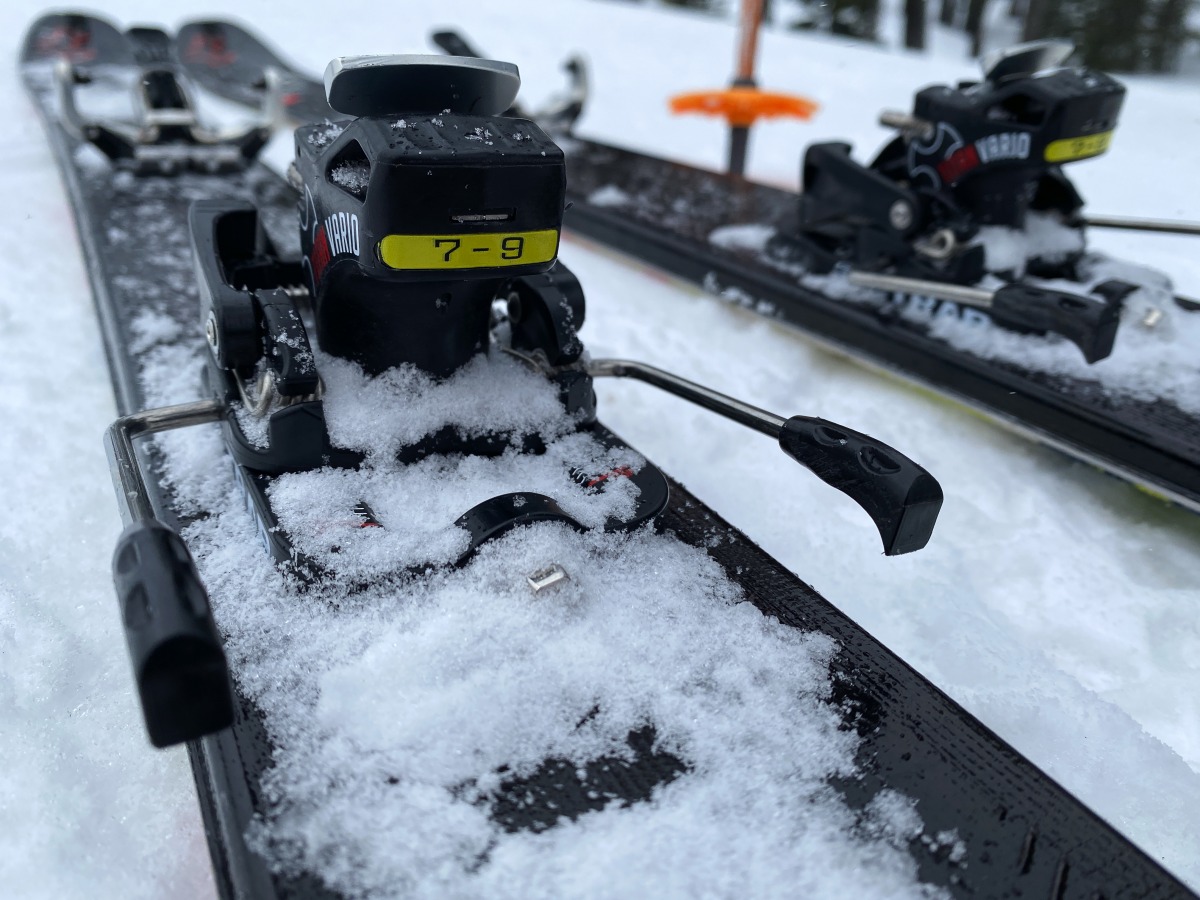
A rear shot of the toe piece. Our setup arrived with breaks and a 7-9 release values. The release values are not adjustible, but falls within the 7-9 range.
The heel piece is also intuitive and simple to use. For quick transitions, simply flip the black U-shaped bar forward to raise the brake, and flip the silver tab forward to engage walk mode; flip both back to go into ski mode.
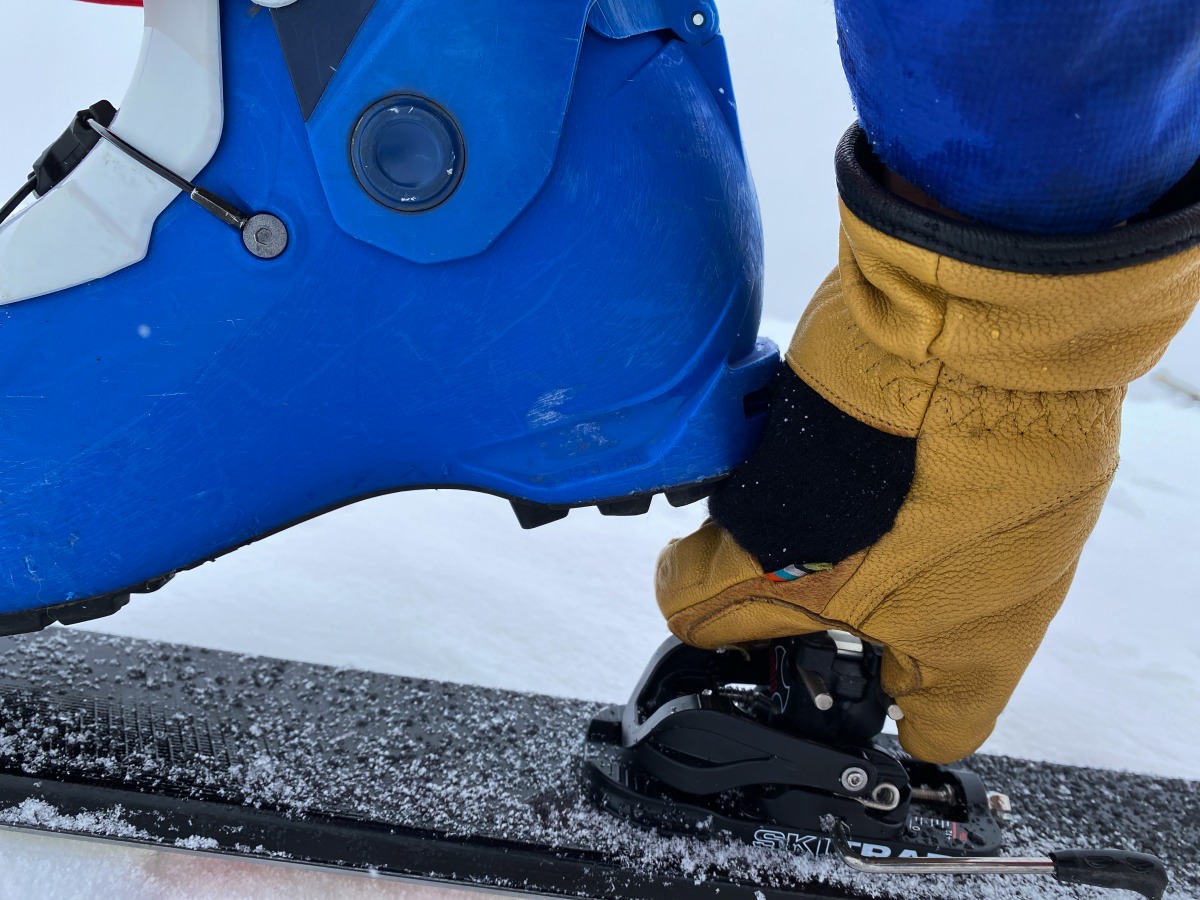
To engage different riser heights rotating the binding at 90-degree intervals is required.
The risers are a bit more complicated, and I don’t love the system—though it’s not a dealbreaker for me either. Ski Trab states that the heel piece has three height settings, and I’ll admit it took me a while to figure out the third setting. First, as described, flipping both the black U-shaped bar and the silver tab forward is the simplest way to go into walk mode, and it’s the middle riser setting (there is no flat). This setting gives 5 cm of height or an ~8-degree rise angle. Next, turn the heel piece sideways and step on the black U-shaped bar for a slightly lower setting (about 3.5 cm or a 4-degree rise angle). For the third option and highest riser, twist the heel piece 180 degrees so the silver tab is toward the tail of the ski. This setting provides 6 cm of added height or an 11-degree rise angle.
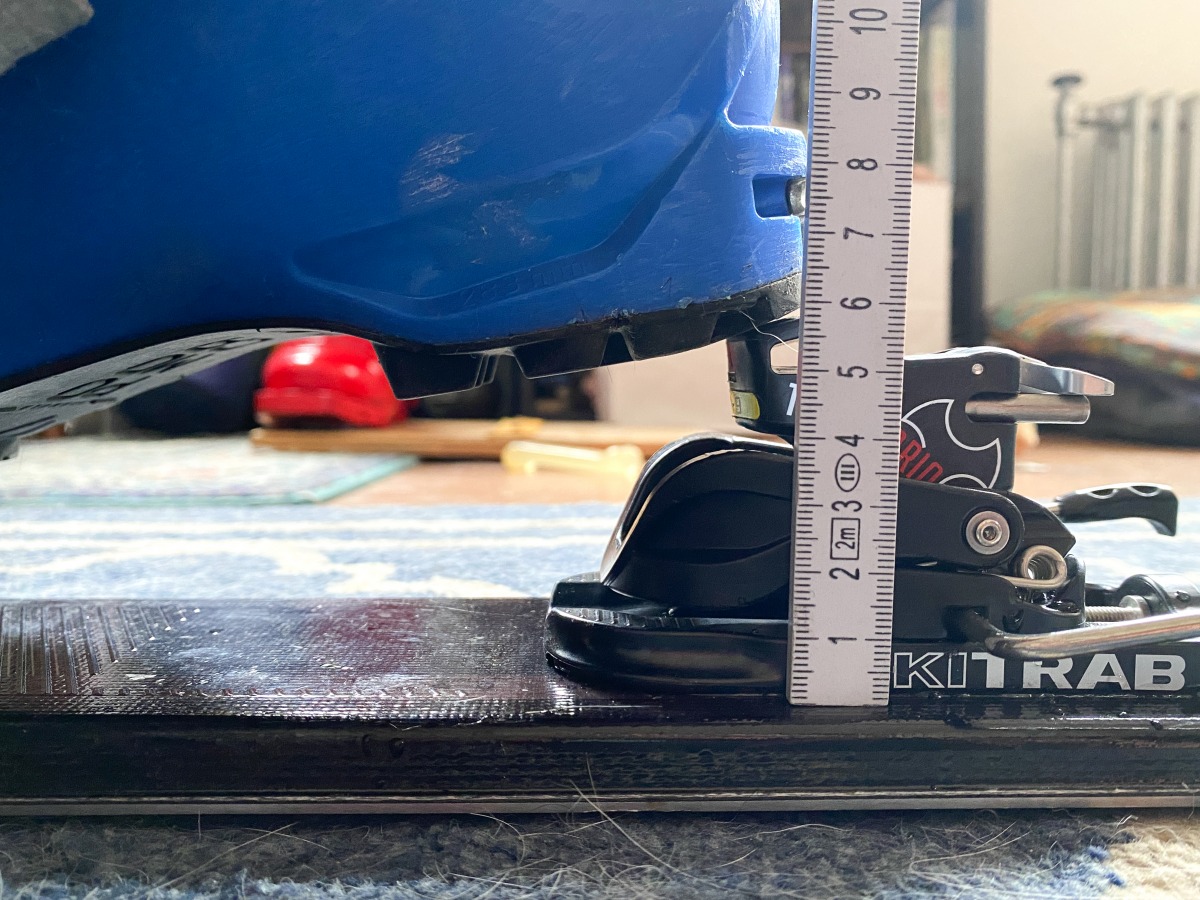
High riser mode.

Middle riser mode (pins forward riser flipped).
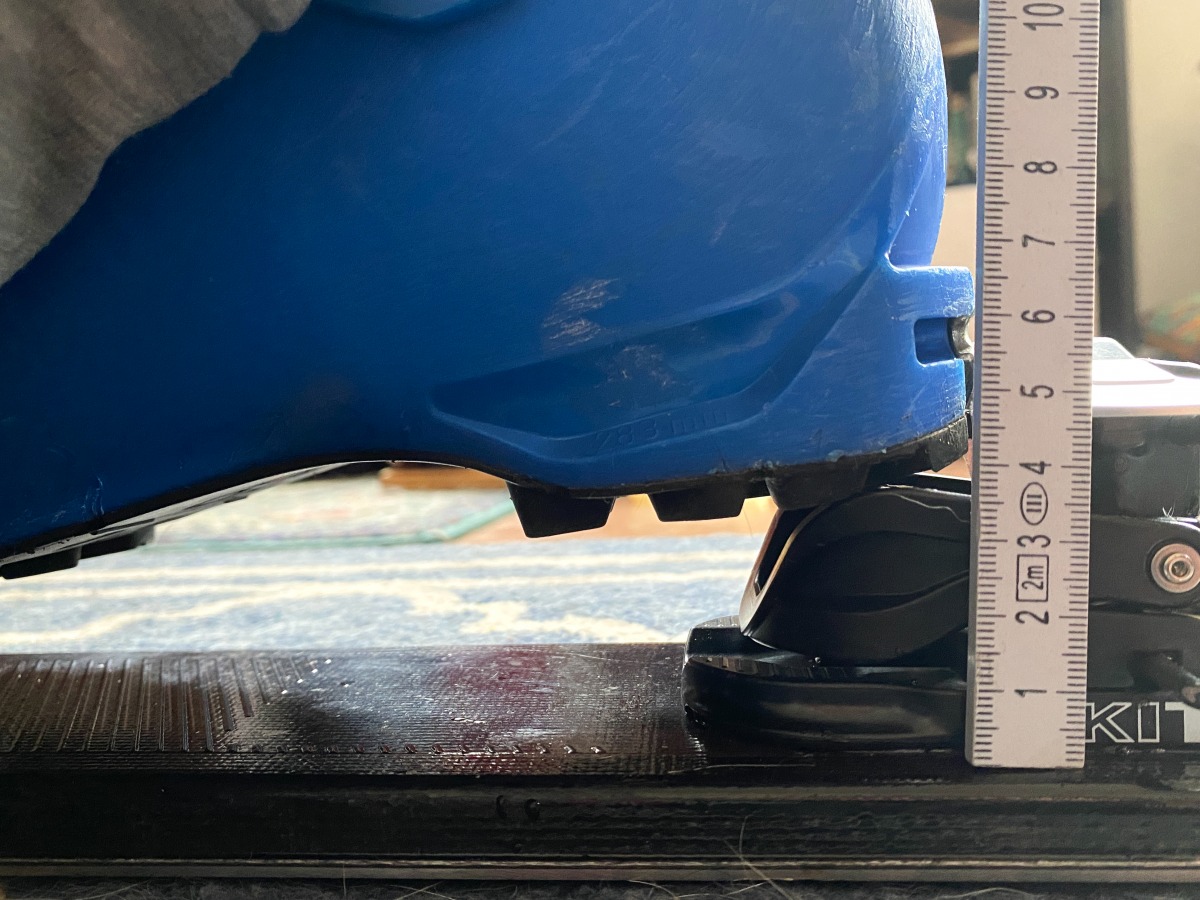
And relatively flat mode.
I don’t love this system because it requires me to stop, bend over, and twist the heel piece with my hand rather than simply using my pole to flip the riser to a higher setting. That said, I’m a big proponent of putting in a consistently graded skin track whenever possible, so I’m already doing everything possible to minimize riser changes when I’m touring anyway—so it’s not a huge deal for me.
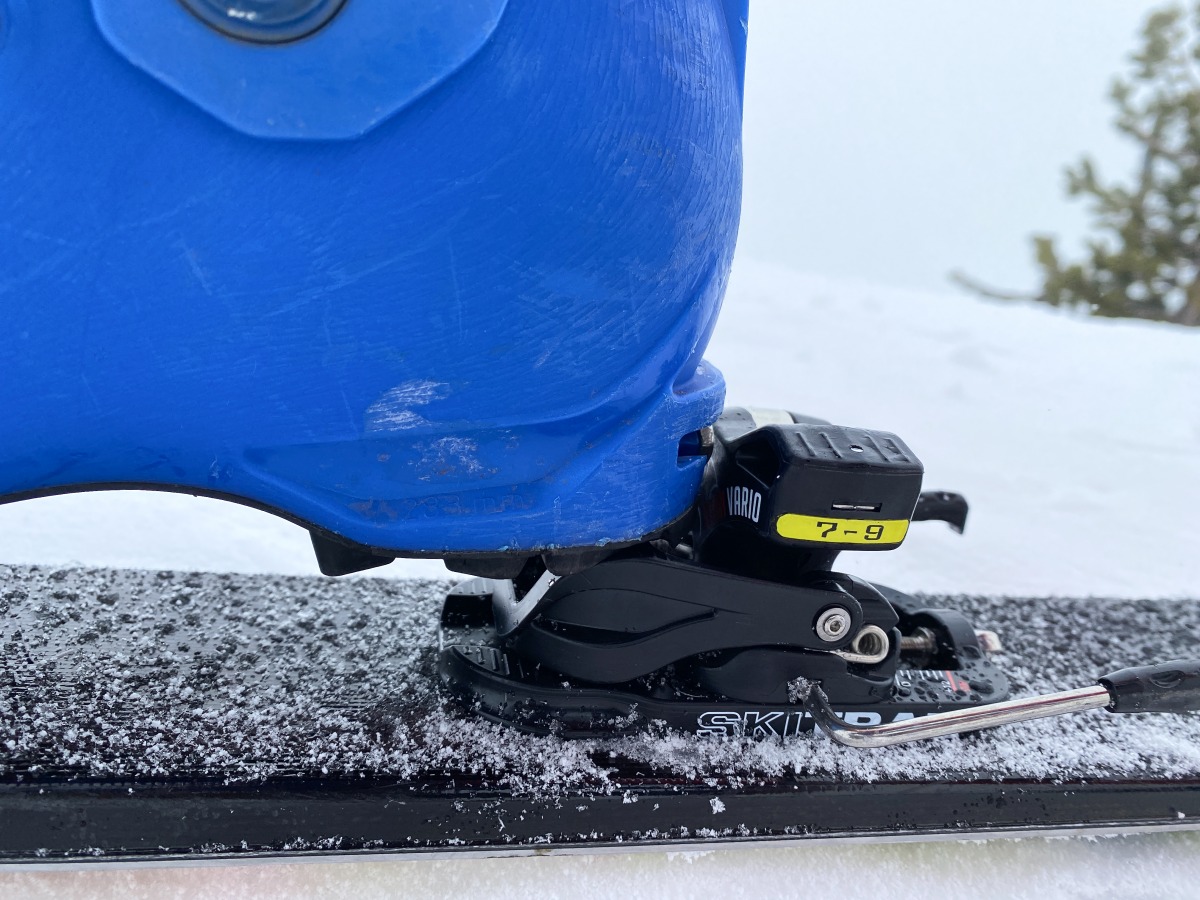
The black wedge underfoot (shown here) is the “flat mode”. This is not a a true flat.
One more note on the heel piece: like the toe piece, the heel piece also has a spring mechanism to reduce the chances of accidental release while skiing fast on hardpack or bumpy snow. The springs are designed to help the binding flex and absorb vibrations and stress—giving the heel piece an elasticity up to 43-degrees while allowing release with prolonged force. The heel piece also sits on an elastic slider track that allows the boot to move up to 7 mm fore and aft, ensuring the binding remains engaged as the ski flexes.
All in all, I think Ski Trab’s bindings offer an innovative and high-performance solution for all backcountry skiers, and I’m looking forward to seeing how the technology and thoughtful design found in the Vario.2 helps push the entire industry forward. For now, I’m a big fan.
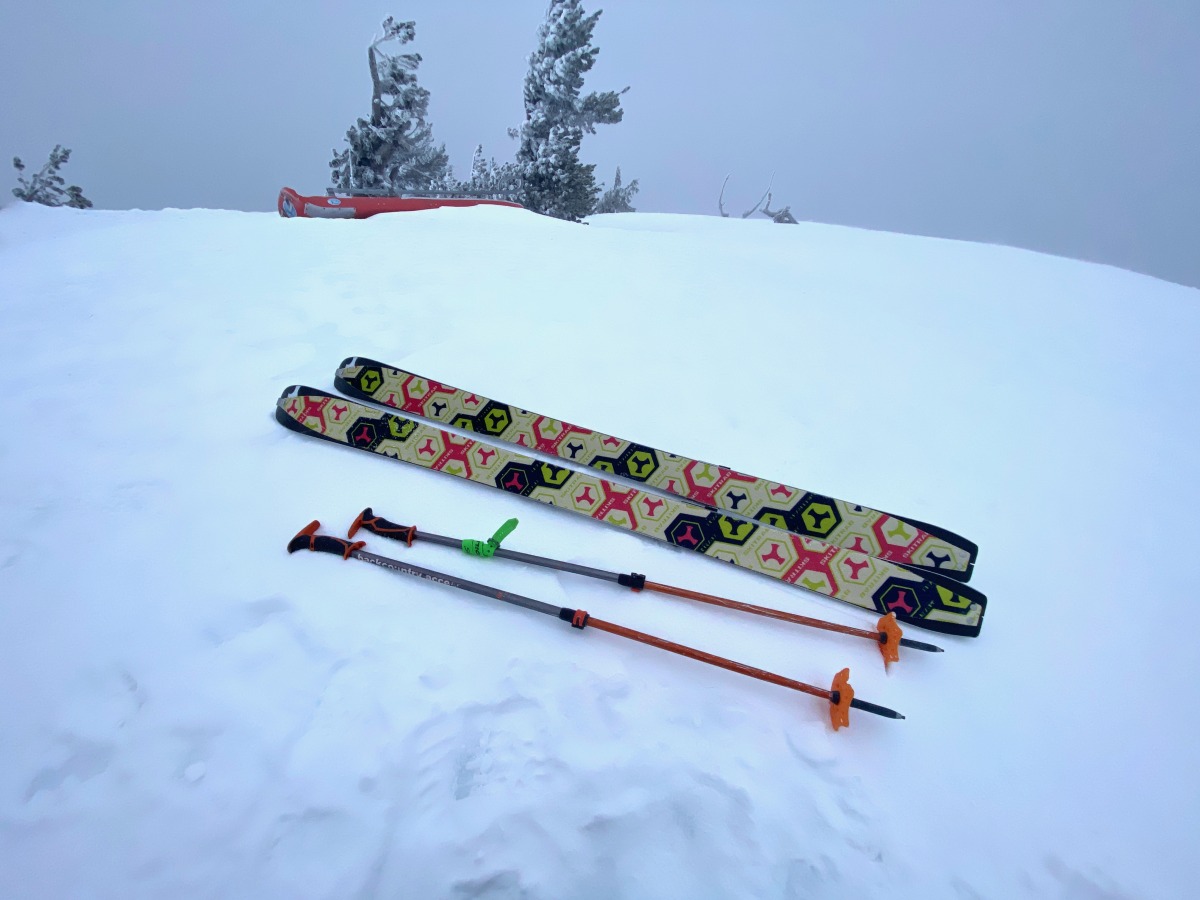
These are branded 100% mohair skins from Contour.
The Skins
As I was hoping, Ski Trab’s branded 100% mohair skins, which I learned are manufactured by Contour (an Austrian company), have gotten better with use. While they’re still quite sticky when folded together, they’ve become easier to rip from my skis—and I particularly love the ability to rip from either the tail or the tip. Both methods are simple and fairly effortless, and it’s one of my favorite features of this entire setup.
On the mohair side of the skins, they’ve performed well and I’ve not experienced any issues with grip or glide. These are solid, reliable skins.
Final Wrap-Up
While I haven’t had many chances to take this setup out to the most classic spring lines yet, I’ve gotten to ski them in just about all other conditions. I would recommend this setup to advanced or expert backcountry skiers and ski mountaineers looking for an ultralight option than can handle a hard-charging descent. With the way they’ve performed so far, I’m looking forward to venturing out toward some of my favorite volcanos in the next two months.
The Basics
Skis
Price: $1100
Lengths (cm): 157, 164, 171, 178
Weight (gr): 1000, 1032, 1055, 1100
Dimensions: 118/88/104, 118/87/104, 118/85/104, 118/85/104
Turn Radius: 19.5, 20, 21, 23
Profile: slight tip and tail rocker, camber
Construction: 14 layer control with composite materials and stratification technology
Core: Aramid, ash wood, light wood
Skins
100% mohair with traditional hot melt adhesive system and Attivo tip and tail fasteners
Bindings
Weight (gr): 309
Material: Ergal, Titanium, Steel Technopolymer
Vertical release: 5-7, 7-9, or 9-11
Lateral release: 5-7, 7-9, or 9-11
Delta: ~+8.5mm
Ski crampon compatible
